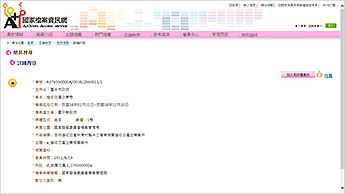

2. Outreach Activities (Reports, Publicity Work, Visitors)
3. Information on Related Document Holdings (United States、Taiwan、Japan)
4. Event Informations on the Related Organs (National Archives, Diplomatic Archives)
The Olympic Games and Japan
Held every four years, 2016 happens to fall on a year during which the Olympics are celebrated. The modern Olympics have been carried out since the Athens Games of 1896, and Japan joined the competition relatively late, in 1912, at the Stockholm Olympic Games. Examining this history through archival documents, this article seeks to cast light on how Japan first entered and competed in the Olympic Games.
- Japanese Performance in the Early Years: From the First Entry to Winning Medals, 1912-1920
Other than those from the British colonies, the modern Olympic Games were initially held for only Europeans and US athletes. Thus from the 1896 Athens Olympic Games to the 1908 London Olympic Games, athletes were not invited from other regions. In order to expand participation from Asia, Baron de Coubertin, the father of the modern Olympic Games, invited a suitable Japanese member to enter the International Olympic Committee (IOC). Consequently, Jigoro Kano, the founder of the Kodokan Judo Institute, was offered membership in 1909 (Reference Code : B07080282000, see [Image 1] (original French text) and [Image 2] (Japanese translation)) . Kano helped to establish the Japan Amateur Sports Association in 1911 which served later as the Japanese Olympic Committee (JOC).
![* Click to Enlarge [Image 1] Title : 4. Recommendation of Kano Jigoro, President of the Japan Kodokan Judo Institute, for membership of the International Olympic Committee (2nd image)](img/020_content01_01_01.jpg)
[Image 1] Title : 4. Recommendation of Kano Jigoro, President of the Japan Kodokan Judo Institute, for membership of the International Olympic Committee (2nd image)
![* Click to Enlarge [Image 2] Title : 4. 4. Recommendation of Kano Jigoro, President of the Japan Kodokan Judo Institute, for membership of the International Olympic Committee (5th image)](img/020_content01_02_01.jpg)
[Image 2] Title : 4. Recommendation of Kano Jigoro, President of the Japan Kodokan Judo Institute, for membership of the International Olympic Committee (5th image)
Japan sent two athletes to the 1912 Stockholm Olympic Games, participating for the first time. Yahiko Mishima (track and field) and Shiso Kanaguri (marathon) did not perform too well. Mishima lost in the preliminary rounds and Kanaguri dropped out of his race, which revealed a considerable performance gap between Japan and other nations. Kanaguri recorded regret in his diary: "this shows a lack of Japanese physical strength and technique." The early Olympic Games were not intended for exclusively top athletes like today, but even amateur sports in Japan had not been highly developed or invested in. In this sense, failure at the Olympic Games shocked Japanese into boosting their competitiveness in sports and to more regularly enter international competitions.
For the 1920 Antwerp Olympic Games, after the suspension of the 1916 Berlin Olympics by the First World War, the Japan Amateur Sports Association asked the Japanese government for financial support for sending participants (* note 1). The request was denied and the Association worked hard to collect public donations from businesses and ordinary citizens. Despite hurdles for entry, the Japanese athletes came home with two silver medals at men's tennis singles (Ichiya Kumagai) and doubles (Kumagai and Seiichiro Kashio), which marked the first Japanese Olympic victories.
- For Better Performance by the Japanese Athletes in the 1920s
For the 1924 Paris Olympic Games, the Japan Amateur Sports Association again requested government support (* note 2) and, upon their second try, received 60,000 yen (approximately 70 million yen today). Japanese athletes were mainly selected by an elimination process, and some proved exceptional, such as the wrestler Katsutoshi Naito. Naito had been captain of his wrestling team at Pennsylvania State College. And because the US Congress passed the Immigration Act of 1924 to exclude Japanese immigrants, Naito was worried if he might run into difficulties as a member of the American wrestling team. However, with cordial support from his university president, he was recommended by Senator Daniel A. Reed of Pennsylvania to the Japanese Embassy in the US for possible qualification as a Japanese participant in the Olympic Games (Reference Code : B04012501700, see [Image 3]) . As a result, Naito was selected as a Japanese member, and won a bronze medal which was the only medal won by the Japanese Olympic team.
![* Click to Enlarge [Image 3] Title : Documents Relating to the International Olympic Games, Vol. 1, No. 5, Games of the VIII Olympiad (Paris) (51st image)](img/020_content01_03_01.jpg)
[Image 3] Title : Documents Relating to the International Olympic Games: Vol. 1, No. 5, Games of the VIII Olympiad (Paris) (51st image)
![* Click to Enlarge [Image 4] Title : Documents Relating to the International Olympic Games, Vol. 1, No. 6, Games of the IX Olympiad (Amsterdam) (45th image)](img/020_content01_04_01.jpg)
[Image 4] Title : Documents Relating to the International Olympic Games: Vol. 1, No. 6, Games of the IX Olympiad (Amsterdam), Division-4 (45th image)
After the passage of four more years, in 1928, the first full-fledged winter games were held in the St. Moritz (the 1924 Chamonix Winter Olympics were done as a trial). Japan sent six athletes in 1928, under Captain Subaru Takahashi, for cross-country skiing and other sports to St. Moritz for their first winter games (* note 3). This was followed by the Amsterdam Summer Olympic Games, where Japanese athletes won two gold medals—Mikio Oda in men's triple jump and Yoshiyuki Tsuruta in men's 200-meter breaststroke swimming. These were the first Japanese gold medalists, and 1928 also witnessed the first Japanese female athlete Kinue Hitomi win a bronze medal in women's 800-meter sprint. Giichi Tanaka, then Prime and Foreign Minister of Japan, sent the following words of praise: "We the people are really proud and happy with the news that the Japanese accomplished outstanding results and gained a great reputation for our 'sports' in Japan and abroad because of the best efforts by the staff and the athletes of our empire. We would like to deeply congratulate their success and express our sincere gratitude to their hard work" (Reference code : B04012502100, see [Image 4]).
- The Olympics at the Mercy of War in the 1930s
Japanese witnessed Olympic fever and gradually a campaign mounted to host the Olympic Games in Japan. Initiating these efforts were Tadaoki Yamamoto, head of the Japanese Olympic national team of the 1928 Amsterdam Olympics, and Shujiro Nagata, mayor of Tokyo. Tokyo officially run as a host city at the IOC Session at Los Angeles in 1932 and was finally accepted, at the IOC Session of 1936 in Berlin, to host the ill-fated 1940 Tokyo Olympic Games (For more detail about the path to the 1940 Tokyo Olympics, see 'Cancellation of the Tokyo Olympics' in the JACAR Special Internet Exhibition, "A Window into the Early Showa Period - Shashin Shuho : Weekly Photographical Journal 1937-1945").
The 1932 Los Angeles Olympic Games were held when anti-Japanese sentiment was growing because of the Mukden Incident of 1931. The next year the foundation of Manchukuo caused disputes over the qualification of participants from Manchukuo in the Olympics. The Manchukuo Amateur Sports Association intended to send the athlete Liu Changchun, but he left for Beijing and eventually participated in the Olympic Games as a participant from the Republic of China, becoming the first Chinese Olympian.
![* Click to Enlarge [Image 5] Title : Documents Relating to the International Olympic Games: Vol. 2, No. 2, Games of the X Olympiad (Los Angeles), Division-4 (31st image)](img/020_content01_05_01.jpg)
[Image 5] Title : Documents Relating to the International Olympic Games: Vol. 2, No. 2, Games of the X Olympiad (Los Angeles), Division-4 (31st image)
![* Click to Enlarge [Image 6] [Image 6] Title : Documents Relating to the International Olympic Games: Vol. 3, No. 3, Games of the XI Olympiad (Berlin), Division-2 (57th image)](img/020_content01_06_01.jpg)
[Image 6] Title : Documents Relating to the International Olympic Games: Vol. 3, No. 3, Games of the XI Olympiad (Berlin), Division-2 (57th image)
Four years later, at the 1936 Berlin Olympic Games, Japan again performed at a high level, bringing home six gold medals, four silver medals and eight bronze medals. Champions included Naoto Tajima (men's triple jump, which Japan has continued to dominate in the last three Olympic Games), Sohn Kee-chung (men's marathon) and Hideko Maehata (women's 200-meter breaststroke swimming; the first Japanese female gold medalist, who is remembered as famous for a live broadcast in which an announcer kept shouting, "Maehata gambare!"). In Japanese government documents for the Olympics in Berlin, there is archival evidence that Nazi Germany devoted enormous resources to propaganda in order to demonstrate its "peaceful" attitude. A report of the International Tourism Bureau described how the German propaganda system was set up and worked in detail. Allegedly, Germans were proud that "nothing could be compared to it in the world in terms of the scale and the organizations of propaganda" (Reference code : B04012503500, see [Image 6]).
As Japanese international relations were strained in the 1930s, public opinion against the Tokyo Olympic Games plummeted with the start in 1937 of the Sino-Japanese War. During a meeting of the Cabinet of Japan, it was decided best to withdraw from hosting the 1940 Tokyo Olympics, and on the following day, the Tokyo Olympic Games Organizing Committee officially informed the IOC of its cancellation (For more detail of the history, see the JACAR Internet Special Exhibition as mentioned above).
Japanese archival materials before the Second World War include a detailed record of the events surrounding the Olympic Games. We can learn from those documents how individuals were sent to participate in the Olympics, how they performed, how Japanese were preparing to host the Olympics, and how Japanese diplomats viewed international affairs concerning Olympic Games. The piles of records left behind by prior generations—silent but vivid if opened—tell us how government officials and ordinary people made concerted effort out of the limelight to build up Japanese Olympians.
[note 1] "Participation of the Japanese Athletes in the Olympic Games in Anvers," August 8, 1919 (Reference code : B04012501500 Title : Documents Relating to the International Olympic Games: Vol. 1, No. 4, Games of the VII Olympiad (Antwerp), Division-1 (6th-7th images))[↑]
[note 2] Japan Amateur Sports Association, "Petition," February 1920 (Reference code : B04012501700 Title : Documents Relating to the International Olympic Games: Vol. 1, No. 5, Games of the VIII Olympiad (Paris) (2nd-7th images))[↑]
[note 3] "Japanese Participation in the Winter Olympic Games," December 9, 1927 (Reference code : B04012501900 Title : Documents Relating to the International Olympic Games: Vol. 1, No. 6, Games of the IX Olympiad (Amsterdam), Division-2 (5th image))[↑]
[References]
Sandra Collins, The 1940 Tokyo Games: The Missing Olympics: Japan, the Asian Olympics and the Olympic Movement, Routledge, 2007.
Kazuo Hashimoto, Maboroshi no tokyo orimpikku: 1940 nen taikai shouchi kara henjo made [The Tokyo Olympics That Never Came True: The 1940 Games - From Invitation to Cancellation]. Tokyo: Kondansha, 2014. (In Japanese)
Wenjie He, "Dai 10 kai orimpikku taikai manshukoku senshu haken mondai ni taisuru nihon to chugoku no taiou: Nihon gaimusho gaiko shiryo to chugoku shimbun "shinho" no bunseki wo tsujite" [The Response of Japan and China to the Manchurian Delegation to the Games of the Xth Olympiad: Through the Analysis of the Documents in the Diplomatic Record Office of Japan Ministry of Foreign Affairs and the Reports in the Newspaper "Shenbao"], Taiikushi kenkyu [Japan Journal of the History of Physical Education and Sport], Vol. 17 (March 2000). (In Japanese)
Masaru Ikei, "1940 nen "tokyo orimpikku": Shouchi kara henjo made" [The 1940 "Tokyo Olympic Games": From Invitation to Cancellation], in Akira Iriye and Sadashi Aruga, eds., Senkanki no nihon gaiko [Japanese Diplomacy during the Interwar Years]. Tokyo: The University of Tokyo Press, 1984. (In Japanese)
Masaru Ikei, "Senzen nihon no bunka gaiko: Orimpikku wo chushin toshite" [Japanese Prewar Cultural Diplomacy with Special Reference to the Olympic Games], Gaikoshiryokanpo [Journal of the Diplomatic Record Office], No. 10 (December 1996). (In Japanese)
Junko Tahara, "Dai 12 kai orimpikku tokyo taikai no kaisai chushi wo meguru shogaikoku no hannou ni tsuite: Gaimusho gaikoshiryokan bunsho no bunseki wo tsujite" [A Study on the Response of Foreign Countries to the Cancellation of the Games of the XIIth Olympiad, Tokyo: Through the Analysis of the Documents in the Possession of the Diplomatic Record Office, the Ministry of Foreign Affairs of Japan], Taiikugau kenkyu [Japan Journal of Physical Education, Health and Sport Sciences], Vol. 38, No. 2 (July 1993). (In Japanese)
Japan Olympic Committee (JOC), "History." (In Japanese)
- The 2015 AAS Annual Conference in Chicago (March 26-29, 2015)
Since its founding in 1941, the Association of Asian Studies (AAS) has promoted the exchange of research on Asia. Leading academics throughout the world gather for the annual AAS conference held in a different US city every March. The conferences are known for their excellent academic research reports and lively discussions that extend over 322 panel sessions. Last year, 3,074 people attended AAS conference held in Chicago from March 26-29 at the Sheraton Grand Chicago. It was the largest event relating to Asian studies in recent years and it was an outstanding opportunity for intellectual exchange of participants.
Like in 2014, JACAR staff members Hiroko Matsuo and Takeshi Sakuma participated in the conference as an exhibitor. Not only did we introduce JACAR's materials and demonstrate how to use our database, but we also surveyed those ideas of participants to improve our services. The survey shows that 60% of people knew JACAR. This was higher than previous year, when a survey showed that 30% of people knew JACAR. More than 80% of those who have browsed JACAR used JPEG format, not Djvu format. Watching such circumstances, a new JACAR system (which will start this coming October) will make it possible to browse all documents in JPEG and PDF format.
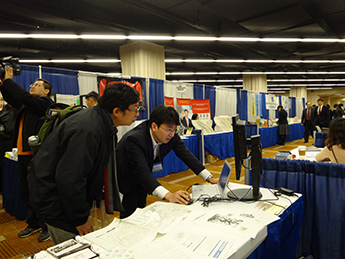
JACAR's booth
Many surveyed believe it would be desirable to improve JACAR's search features, such as glossary search (the term lists of government organizations, titles, etc.). To meet such demands, we have provided a topic browsing function in the online special exhibit "Post-World War Two Demobilization and Repatriation". We will continue to conduct surveys to understand the users' demand.
- 2015 Open Forum sponsored by the American Association of Teachers of Japanese (March 26, 2015)
The American Association of Teachers of Japanese (AATJ) is an association for promoting Japanese-language education. It is run by Japanese-language teachers of primary, secondary and higher educational institutions in the US. Every year the AATJ annual spring conference is held at the same time and venue as the AAS annual conference. Last year, it was held in Chicago at the Sheraton Grand Chicago on the evening of March 26, 2015, one day before AAS. On the evening of 26, AATJ Open Forum was held by JACAR and the Consulate-General of Japan in Chicago at the Center of Information and Culture of the Consulate-General. JACAR staff members were invited to take part in the forum and introduced the activities of JACAR. At the event, Masato Ootaka (Minister, Japanese Embassy in Unites States) offered greetings and Shigeru Miyagawa Professor of Linguistic at MIT, Project Professor and Director of Online Education at Tokyo University) gave a keynote speech. The keynote address was entitled "Open Education: Transforming the Educational Mission of the University" and it introduced the history of open education, Open Course Ware (OCW) and massive open online course (MOOC). After the keynote speech, we were able to have a meaningful exchange of opinions concerning availability of JACAR's materials for MOOC with Prof. Shigeru Miyagawa.
- JACAR in Korea: Visiting Korea National Diplomatic Academy (Seoul) and Keimyung University, College of
International Studies (Daegu) (May 27-28, 2015)
In May of 2015 JACAR Director-General Sumio Hatano lectured with our researcher Muneaki Hirano about JACAR at two Korean institutions.
On May 27th, Dr. Hatano and Mr. Hirano visited the Institute of Foreign Affairs and National Security of Korea National Diplomatic Academy (KNDA) in Seoul. The KNDA is Korea's national organization for training diplomats. The institute is a governmental organization for foreign policy research.
Director-General Hatano's lecture "The San Francisco Peace Treaty Regime and the Japan-Korea Relationship" was attended by researchers of KNDA and of other institutions including Seoul National University. We distributed JACAR pamphlets of Korean language to those who attended. Dr. Jo Yanghyeon of KNDA chaired the conference and introduced JACAR to the participants. We presented our services in detail to KNDA researchers and others. At first we explained the outline and significance of JACAR, and then we presented our services in detail and documents related to Korea in our database.
We received a variety of questions from the audience and discussed with them. These questions included: "Which Japanese government institution holds administrative documents of the Korea-Governor's General Office?" and "As JACAR was established to further research into historical issues and to distribute historical documents among the people, isn't it important for JACAR to release documents after the end of the Second World War and the San Francisco Peace Treaty?".
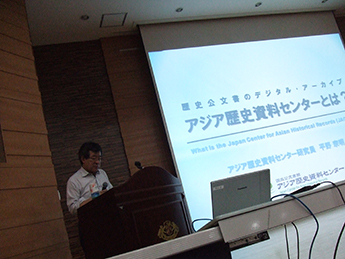
JACAR's presentation (by Director-General Hatano)
On May 28th, we traveled to Keimyung University in Daegu. The Department of Japanese Studies in the College of International Studies of the university is one of the main institutions for Japanese study in Korea. We introduced JACAR to about sixty students and teachers. We showed the JACAR website, some of its contents, and also documents related to Korea. After our introduction, JACAR's Director-General Hatano gave a lecture titled "The San Francisco Peace Treaty Regime and the Japan-Korea Relationship".
Not all the students at the presentation were history majors and few of them had known JACAR. Students listened carefully to our presentation. Many teachers seemed to be even more interested in JACAR's services, particularly in Japanese army documents on the March 1st Movement. After the presentation, we received high appraisal from the teacher who has been using JACAR.
We introduced JACAR in Korea in 2015, following 2014's presentations at Seoul National University and Kookmin University. We found that those who had known or used JACAR, especially university faculty members, gave higher evaluation to our services. They also expected the extension of our database coverage to include more recent documents. Some of the people we've met, particularly young students, did not know of JACAR despite of their interests in Japanese and Korean modern history and the Korea-Japan relationship. It seems important for us to keep looking for opportunities for publicity in Korea.
- The 2015 AAS-in-Asia in Taipei (July 22-24, 2015)
The North American-based Association for Asian Studies (AAS) is the conference which consists of scholars who major in Asian region studies. The first AAS in Asia conference was held in 2014 in Singapore, and the second held in Taiwan (2015), the third held in Kyoto (2016). The next conference will be in Korea (2017).
In 2015, Academia Sinica hosted the second AAS in Asia event, which had six roundtables and 105 panel sessions. Approximately 600 participants attended the 3 days conference.
JACAR staff members Hiroko Matsuo and Taikan Ono exhibited a booth at the main conference site for publicity activities. Many participants visited our booth between sessions, so there were a lot of opportunities to introduce JACAR's resources and demonstrate how to use our database. At the booth, JACAR staff also distributed leaflets and souvenirs while surveying the ideas of participants concerning how to improve our services.
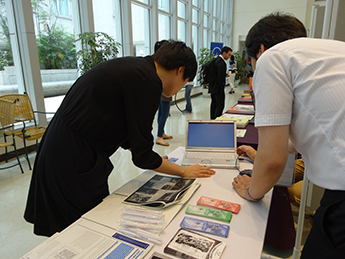
JACAR's booth
Visitors to our booth were mostly scholars of Chinese or Southeast Asian studies, because this conference was held in Taipei. There were not so many scholars of Japanese studies, so real JACAR users were small in number. As we showed the database's huge selection of documents related to China and Southeast Asia, as well as documents written in Chinese and English. Some scholars showed their strong interests in browsing our database. So our activities at the AAS in Asia conference were fruitful, as we were able to outreach to those who have not use them in their research.
-Overseas
|
March 30-April 6, 2016
|
Held a booth exhibition at the annual conference of AAS in Seattle.
Had discussions about researching archival documents with staff of the East Asia Library, University of Washington.
Held discussions on researching archival records with archivists of the National Archives at Seattle.
Visited the Boeing Archives in Bellevue, Washington, to see their corporate archives.
|
-Domestic
|
June 9, 2016
|
Held presentation at Komaba Library, The University of Tokyo.
|
|
June 24-28, 2016
|
Held a booth exhibition at AAS-in-ASIA in Kyoto.
Had discussions about researching archival documents with staff of the Institute for Research in Humanities, Kyoto University.
Had discussions about researching archival documents with staff of the Maizuru Repatriation Memorial Museum.
Had discussions about researching archival documents with staff of the Kyoto Prefectural Library and Archives.
Held presentation at Kansai University.
|
|
March 24, 2016
|
Chinatsu Tomita, Librarian in charge of the Okinawa Materials, University of the Ryukyus Library.
|
|
April 12, 2016
|
Chang Che-chia, Associate Research Fellow and Director of Archives, Institute of Modern History, Academia Sinica
|
|
July 6, 2016
|
Azusa Tanaka, Japanese Studies Librarian, East Asia Library, University of Washington.
|
This past March JACAR staff members Hiroko Matsuo and Takeshi Sakuma visited two American organizations that house Japan related materials. The pair from JACAR conducted interviews about archival digitization and investigated the conditions of materials related to Japan. The conditions of the two visited organizations are outlined below.
University of Chicago
The University of Chicago is a prestigious, world famous private university that was founded in 1890. It has produced many Nobel Prize Winners and has about 5,700 undergraduate students, 9,500 graduate school students and almost 2,200 faculty members engaged in full time. East Asia studies began in Chicago with Chinese studies in 1936, and the Committee for East Asian Studies was established in 1951. The Japanese studies program started in the 1950s, the Korean studies program started in the 1980s. In addition to the Department of East Asian Languages and Civilizations, Chicago also has a Center for East Asian Studies (CEAS). In the Center, there are three committees—China, Japan, and Korea Committees; each consists of related faculty members of the campus. The chairperson for Japan Committee at the time of my visit was Associate Professor of East Asian Languages and Civilizations Susan L. Burns. JACAR staff members were able to have discussion and exchange ideas with Associate Professor Susan L. Burns (a specialist in Japanese history), Associate Professor Hoyt J. Long (a specialist in Japanese Literature) and Associate Professor Dr. Chelsea Foxwell (a specialist in Japanese art history). We introduced the JACAR database as well as how to retrieve photographs, maps, drawings, and figures. We also looked at some research uses for these materials.
- Regenstein Library in Chicago : East Asian Collection (→Website)
Regenstein Library is one of the six University of Chicago libraries and it was built in 1970. The seven-story (five above the ground) library holds more than 4.5 million of printed materials concerning humanities and social sciences, and the East Asian Collection is on the library's fifth floor.
The East Asian Collection began in 1936. It currently holds more than 850,000 physical materials including books, newspapers, periodicals, and microfiche that were written in major East Asian Languages (mainly, Chinese, Japanese, and Korean). These include 550,000 Chinese, 230,000 Japanese, and about 90,000 Korean books and other printed materials. There are also items written in East Asian minor languages (Tibetan, Mongolian, Manchurian) as well as 60,000 books in English and other Western languages.
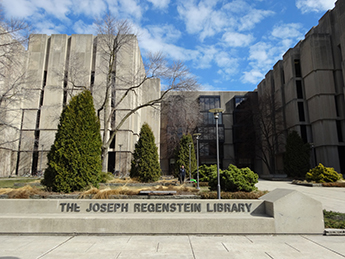
Regenstein Library
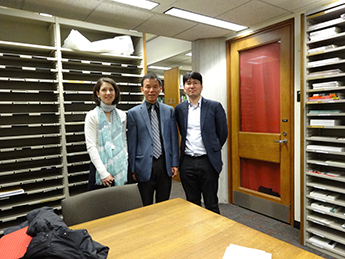
Dr. Chelsea Foxwell (Left)and Dr. Yuan Zhou (Center)
Research on Japan at the University of Chicago gained momentum after the 1950s, and the Japanese book holdings increased, especially in the 1970s and the 1980s. Area studies was further recognized, and the Japanese collection was bolstered with the University's growing financial support as well as the financial support from Japan. Notably, a consortium in Osaka funded with local university and corporate donations enriched holdings concerning East Asian literature, history, art, religion and other topics. The five story library holds more than 450 thousands books concerning the social sciences, and the East Asian Collection is on the library's fifth floor. The East Asian Collection began in 1936. It currently holds about 850,000 physical materials including newspapers, periodicals, and microfiche that were written in major East Asian Languages (mainly, Chinese, Japanese, and Korean). This includes 55,000 Chinese books, 23,000 thousand Japanese books, about 9 thousand Korean books. There are also items written in East Asian minor languages (Tibetan, Mongolian, Manchurian) and six million books written in English and other Western languages.
The Japan-United States Friendship Commission also has helped to enrich the University of Chicago East Asian cook holdings and it created a Michigan-Chicago Library Consortium.
The University of Chicago also houses [1] the Hatano Kanichi Collection, [2] Matsumoto Bunko: Chūgoku kankei shinbun kirinukitoji, and [3] Japanese materials on Chinese military and political organizations in the 1930's and 40's. These documents have been microfilmed.
[1] Kenichi Hatano (1893-1963) was a journalist as well as a researcher of China who served before the Second World War as a part-time employee of the Intelligence Bureau of the Ministry of Foreign Affairs and then as a part-time employee of the Board of Asia Development. From the catalog of this collection, we can confirm many reports concerning the activity of the Chinese Communist Party. But unfortunately this collection had an issue with its number, we couldn't confirm its content in the Library. However, this same collection of materials is also held in Tokyo by Toyo Bunko.
You can view on JACAR's website for a related track record of the Chinese Communist Party from 1932-1937 written by Kenichi Hatanao (Diplomatic Archives of the Ministry of Foreign Affairs>Records of Investigation>Information Department>Chinese Communist Party 1932 annals / 1933 ).
[2] Tadao Matsumoto, who served as Parliamentary Vice-Minister of Foreign Affairs and as a councilor of the Minsei Party, collected newspaper clippings relating to China, Taiwan, and Korea in Japanese and Chinese newspapers. The materials range from the end of Shin Dynasty in China to the early days of the Republic of China. A duplicate of the materials were bought by the former Tokyo Metropolitan University library. There are about 300 rare materials in the collection (the so-called Matsumoto Records), which were transcribed by Matsumoto when he served as Parliamentary Vice-Minister of Foreign Affairs. The records relate in particular to politics, foreign affairs, treaties, loans, and losses of records that were incinerated at the end of the Second World War. You can browse the Matsumoto Records on the JACAR database.
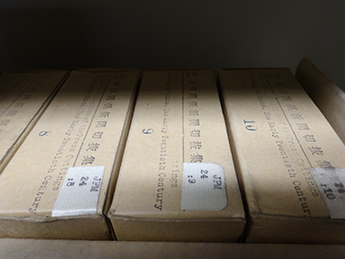
Matsumoto Records
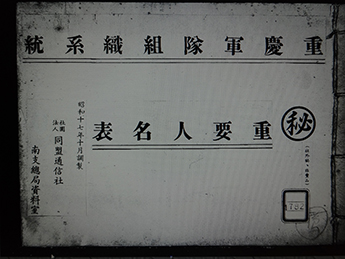
Japanese materials on Chinese military and political organizations in the 1930's and 40's
[3] "Japanese materials on Chinese military and political organizations in the 1930's and 40's" is a collection created by the General Bureau of South China, Domei Tsushinsha (Domei News Agency). It includes government army documents and materials of the Chinese Nationalist Party. There was not a catalog of this collection, therefore one must search titles written on microfilm boxes. The collection is an essential record of human resources and the political system in 1930's and 40's. You can see the records with Toyo Bunko by checking the title name 同盟通信社南支総局資料室編『重慶政権党政軍組織並重要人名録』1943年.
[References]
Catalogue of the Kenichi Hatano Collection (National Diet Library of Japan)
Eizaburo Okuizumi, Norio Okada, Materials on China, 1920-1950, from Japanese research sources : a user's guide to the microfilm edition of the Hatano Collection, University of Chicago, East Asian Library, 1990.
Round-table Talk "Matsumoto Records : it's history and value as historical material", Journal of the Diplomatic Archives 5 (March 1992). (in Japanese)
- The Joe and Rika Mansueto Library (→Website)
The University of Chicago's Joe and Rika Mansueto Library is a new library building constructed in 2011. It was built due to a shortage of space in the existing university libraries, with the contributions of Mr. and Mrs. Mansueto. The Mansueto Library has a grand reading room with 180 seats, and also the home of the Library's preservation department which includes a unit of digitazation lab. The Mansueto is equipped with an automatic high density book retrieval system that accommodate 3.5 million volumes of books. The system is installed undergraound. The digital unit has equipment including an overhead camera and a book scanner for digitizing some types of damaged materials. And there are image correction tools and a studio for digitization of large materials. The digital unit uses the PDF format.
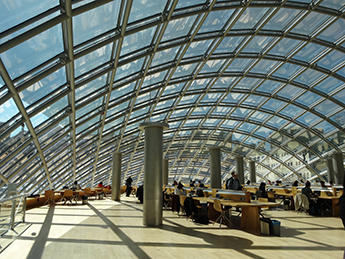
Reading Room
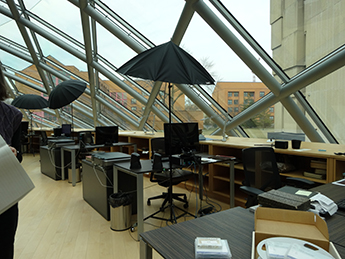
The digital unit
Northwestern University
Northwestern University is a prestigious, world-famous university that was founded in 1851. Northwestern University is ranked as a top tier school in the U.S. university ranking system. The university has its main Campus is Evanston, a suburb of Chicago. The medical school and university hospital are in the city of Chicago and there is a satellite campus in Qatar. In total there are about 8,000 combined graduate and undergraduate students. JACAR staff members were able to discuss research and exchange ideas with Professor Laura Hein (specialist modern Japanese History). We introduced the JACAR database as well as how to retrieve photographs, maps, drawings, and figures.
- Northwestern University Archives (→Website)
The Evanston campus of Northwestern University houses its Main Library and the Charles Deering Library. Serving today as the center of the university library system, Main Library ecliplsed Charles Deering Library, which had been the center from 1933 to 1970. Today Charles Deering Library houses the university's archives.
The Northwestern University Archives, which were started in 1935, hold materials relating to every aspect of Northwestern University's history. The preservation of materials includes old university records, papers of faculty members, and records of student organizations-- as well as publications, photographs, audio-visual materials, artifacts that are open to the public for research and reference. The university archives excute document managemanet in accordance with guidelines formulated by Society of American Archivists.
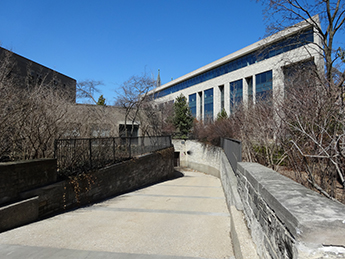
Entrance of Archivist cabinet
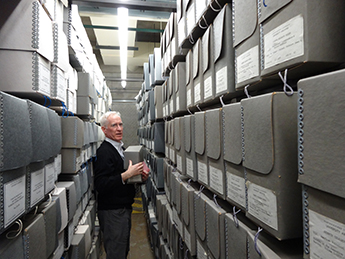
cabinets
We checked the following documents held by the Northwestern University Archives: [1] "John Henry Wigmore (1863-1943) Papers", [2] "Kenneth W. Colegrove (1886-1975) Papers".
This precious collection is helpful in understanding the formation of Japanese modern law in the Edo and Meiji eras. The papers were donateed from Northwestern University Professor John Henry Wigmore, who made efforts towards establishing Keio University's Faculity of Law. The collection includes lecture notes on Japanese legal history, research data, information on a relationship with Yukichi Fukuzawa while at Keio University, as well as letters corresponding with foreigner employees of Minpoten Ronso (on disputes over legal codes that provided for basic stipulation of civil codes).
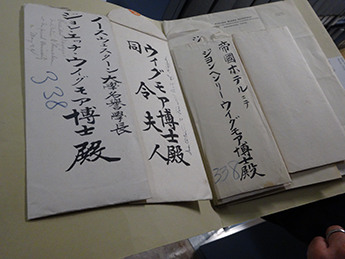
John Henry Wigmore Papers
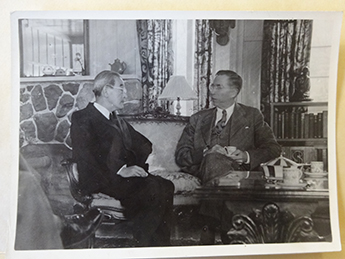
Kenneth W. Colegrove Papers(Left Ikuo Oyama)
The "Kenneth W. Colegrove(1886-1975) Papers" is a collection of private documents donated from the wife of Kenneth Colegrove. Kenneth Colegrove was a professor of political science at Northwestern University, and he served as an adviser of Japanse constitutional issues during the U.S. Occupation of Japan. Colegrove also lecured on Japanese civil affairs at Northwestern University to prepare U.S. personnel for the Japanese occupation. Colegrove patroned Ikuo Oyama in both his career and private life. Oyama was a chairman of the Japan Labour-Farmer Party and a professor of philosophy, politics and economics at Waseda University. Oyama served Colegrove as his assistant for research of Japanese political science at Northwestern University, so Colegrove's collection includes articles as well as letters with Oyama on the Meiji Constitution and other topics. This collection is indispensable to study the transitional ideas that helped build the current Constitution of Japan.
[References]
ARCHIVAL AND MANUSCRIPT COLLECTIONS Guide to the Kenneth W. Colegrove (1886-1975) Papers.
Naoyuki Umemori, "An experience of 'exile' : Ikuo Oyama's 5150 days in Evanston", The Waseda journal of political science and economics No.341(Jun 2000). (in Japanese)
In June 2015, JACAR staff members Hiroko Matsuo and Taikan Ono visited two organizations in Taiwan that hold Japan related materials. The JACAR team conducted interviews about the archival digitization of the materials and investigated their conditions. Such matters regarding the Taiwan materials and organizations are outlined below.
- National Central Library (國家圖書館) (→Website)
The National Central Library was originally founded in Nanjing on Mainland China in 1933. However, due to intensification of The Sino-Japanese War, the library was transferred to Chongqing in 1937 and then it opened in 1941. The rare book collection of the National Central Library was moved to Taiwan due to domestic fighting in China from the end of 1948 to 1949. In the end, the National Central Library was completely relocated to Taiwan with the defeat of Nationalist Party (Kuomintang), and it officially reopened in February 1954 in Taipei.
National Central Library is, as a unique central library, part of a national agency in Taiwan. It is designated as an institution to receive legal deposits and it is ordered to gather, catalogue and hold all publications created in Taiwan. National Central Library releases all holdings for general and academic use. Holdings include 4 million materials such as publications, governmental materials and books created in Taiwan which were gathered from 1954. There are 200 thousand materials related to Japan in the holdings.
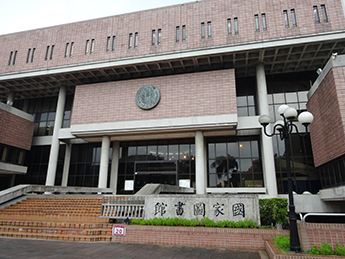
Appearance of National Central Library
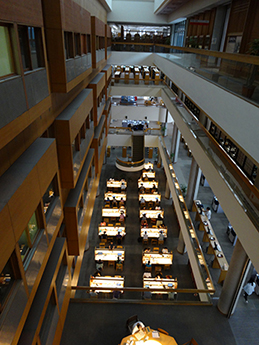
Inside of National Central Library
Except for the rare book collection, the holdings of the National Central Library mainly consist of Chinese publications created in Taiwan after 1949. There are also about 600 materials that relate to Taiwan, which were created under Japanese domination. Those materials were gathered from 1949 and they have been digitized, although it is also possible to browse them in the National Central Library.
Other Japanese materials held by The National Central Library were gathered by purchases, donations or exchanges with National Diet Library of Japan. It is possible to read all Japanese materials including the above mentioned ones created under Japanese domination in the Japanese-Korean Collection Room. You can search Japanese materials held at "The National Central Library with an online catalog (館藏目錄查詢系統) ".
The rare books collection mentioned above is in the Rare Books Collection Room. Rare Books Collection Room has more than 12,900 sets (ca. 135,000 volumes) of rare books, including Dunhuang scrolls; Song, Jin, Yuan, and Ming books; hand copies; manuscripts; and annotated versions. The items are kept in special bookshelf which is made of cypress, and they are given to readers as copies or digitized materials in principle.
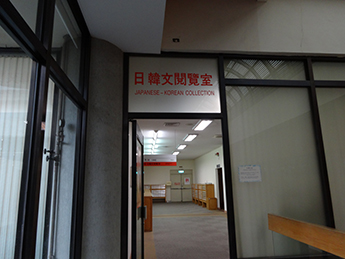
Japanese/Korean Collection Room (日韓文閱覽室)
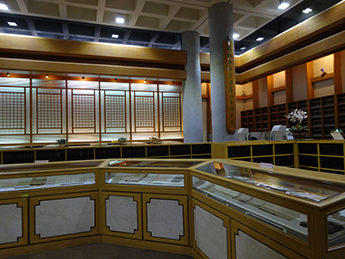
Rare Books Collection Room (善本書室)
In addition, in 1981 The National Central Library established the Chinese Studies Information and Services Center for promoting Chinese studies internally and externally. The Chinese Studies Information and Services Center was renamed The Center for Chinese Studies in 1987. The Center for Chinese Studies primarily has materials written in simplified Chinese characters.
As for digitization of their holdings, the National Central Library started as a member of a digitization project of the Taiwanese Government from 1998 to 2012, and they established a digital database in 2002. The objects for digitization include the above mentioned documents created under Japanese domination, rare books, contracts created from the Qing dynasty era to the Japanese donation era, family trees, rubbings, post cards and graduation album. In some cases, the National Central Library borrowed materials from individuals or associations, private libraries as the objects for digitization, and returned them to original owners after finishing digitization.
The digitized materials can only be browsed in entirety in the Library. Outside of the Library, you can only browse digitized online catalogue data and thumbnail images.
In addition, they have special content on their website. For example, you can browse the pictures and postcards taken under Japanese domination by going through "Taiwan Memory (臺灣記憶) ".
- National Archives Administration, National Development Council (國家發展委員會檔案管理局) (→Website)
National Archives Administration was established under the Research, Development, and Evaluation Commission of Executive Yuan in November 2001, and it was transferred to the National Development Council in January 2014. The main duties of the National Archives Administration are to gather "National Archives (國家檔案) ", hold and release them, and to formulate guidelines related to document administration, preparation for the system of document administration, supervision to government agencies for document management and release of holdings.
In Taiwan, according to the Archives Act (檔案法) enacted in January 2002, the documents created by government agencies designated as permanent records were transferred to the National Archives Administration. After that, those documents have been wholly managed by the National Archives Administration as "National Archives (國家檔案) ". Except for items with the label "National Archives", other documents created and managed by government agencies and are named "Government agency records (機關檔案) ". Such matters are regulated in the Archives Act. And according to the article 22 of the Act, documents designated as "National Archives" have to be released for general use within 30 years after creation except for special circumstances.
As for selection of "National Archives" and transfer of them to the National Archives Administration, in principle, firstly government agencies judge the documents of an expired retention period as to whether they meet the definition of "National Archives" or not based on the Archives Act. After that, government agencies send the results of judgment to the National Archives Administration, and do an examination. There is also a method that the National Archives Administration directly designates the documents as "National Archives". There are some methods to select "National Archives" by the National Archives Administration, like objective selection, based on the regulations of law. The other method is subjective selection on the basis of opinion by a committee consisting of specialists.
→The National Archives Administration introduction movie
The documents transferred to the National Archives Administration are classified four levels as fonds (全宗), series (系列), file (案) and item (卷), after that they are preserved. The materials held by the National Archives Administration consist of media, including print, photographs, audiovisual contents, and digital sources. The archives also collects private materials by donation, deposit or purchase, in addition to governmental agency records.
The National Archives Administration holds the following documents related to Japan: documents related to requisition of Japanese assets after World War 2 (接收日產), Japanese repatriation after World War 2 (遣送日僑), and anti-Japanese salvation groups (抗日救國團). You can see the details of holdings of the National Archives Administration with the link below.
You can search catalogues of "National Archives" by keyword at the Archives Access service managed by the National Archives Administration with the link below. Catalogues of "National Archives" have the fields as follows; fond category (全宗名), file name (案名), date of creation (檔案起迄日期), creator (檔案產生者), media type (媒體型式), summary (內容摘要), theme (主題), situation of digitization (數位化資訊). Among them fond category, file name, date of creation, creator, summary, and theme belong to the search object.
For general usage and showing documents and materials, the National Archives Administration has a reading room named Archives Access Center and an exhibition space.
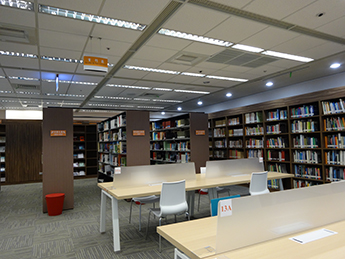
Archives Access Center
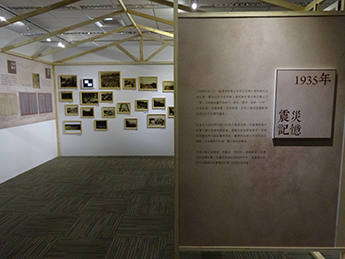
Exhibition Space
The National Archives Administration built a system in 2009 to cross search several organization databases, including other archives, libraries, museums and universities. The system is called ACROSS (Archives Cross Boundaries, 檔案資源查詢整合平台). It is connected to Academia Historica, Academia Sinica, National Central Library, National Taiwan Library, National Palace Museum, National Taiwan University, etc.
As for the digitization of materials, 5% of all holdings were digitized as of June 2015. The archive prioritizes digitizing documents with high demand or with a strong possibility of damage. The digitized materials can be browsed in entirety at the Archives Access Center. Furthermore, it is possible to receive digitized materials on CD or by email for those that are permitted through the system.
In addition to digitizing materials, since 2013 the Electronic Documents and Records Service Center in the National Archives Administration has been promoting electronic archives and electronic authentication while developing it.
Researcher Takeshi Sakuma and Taikan Ono this past November visited Hiroshima Prefectural Archives. The pair from JACAR conducted interviews about archival digitization and investigated the conditions of materials. What the staff members learned about the organization is outlined below.
- Hiroshima Prefectural Archives (→Website (Japanese))
The history of the Hiroshima Prefectural Archives goes to back to a November 1958 suggestion from the Science Council of Japan to create an archival alliance in Hiroshima for "preventing loss of official documents". With such a movement, the collection of discarded administrative documents began in Hiroshima in March 1966. From April 1968 to March 1984, it was researched how to best manage the preservation and storage of government documents, and they were kept on site from April 1988 at Hiroshima University's Faculty of Engineering.
Since this time the Hiroshima Prefectural Archives have annually collected, sorted, and discarded huge volumes of administrative documents of Hiroshima government offices. Upon thirty years of preservation, documents are given an additional screenings, after which almost 57,000 files have been preserved as permanent materials. In addition to official documents, there are about 104, 000 books as well as some 249,000 historical manuscripts from the government, affiliated and civilian organizations (these general manuscripts include unofficial document files that were donated or deposited, and among them are government designated Intangible Cultural Properties). As of March 3, 2016 there were also about 2,360,000 items compiled for a project of historiography by Hiroshima Prefecture (40,000 files), including microfilms of historical manuscripts and 23,000 books concerning the local municipal history of the prefecture. These materials held by Hiroshima prefectural archives are open to the public with the exception of some which were kept confidential to not impinge on the rights of private citizens and organizations.
The Hiroshima Prefectural Archives holds many administrative records on demobilization, reparation, and the occupation of Japan by British Commonwealth forces after World War Two. There are also newspaper records documenting how many from Hiroshima prefecture were sent abroad to São Paulo (in Nippak Shimbun), Hawaii (in the Maui Shinbun), San Francisco (in the Nchi-bei), Vancouver (in The Continental daily News), and Colorado (The Colorado News). The archives contain photographs and catalog information with immigration related duplicate records that were published as "Hiroshima Prefecture History". Many records relate to the atomic bomb, and there is a copy of the photo collection LIVING HIROSHIMA, compiled in "Hiroshima city Tanaka Tsuguzo" which was published by the Hiroshima tourism association in 1949. It is held by the archives, displaying the city transitioning from ruin to restoration. Hiroshima Prefectural Archives has many of its collections available online, and Many people check the "Nagafune Tomonori collection" which are consist of picture postcards created from Meiji era to the early Showa era.
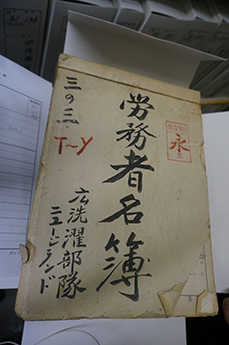
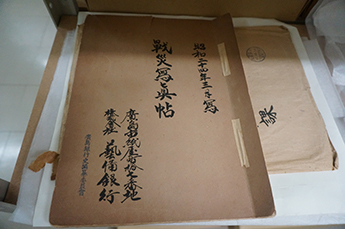
The archives publishes an annual work titled Hiroshima Prefectural Archive News in March to promote the use of the archives while introducing information on new collections and document releases, events, articles, essays on documents, other publications, and historical manuscripts in Hiroshima prefecture.
[References]
Hiroshima Prefectural Archives 'Administrative Records' (in Japanese)
Hiroshima Prefectural Archives 'Newspaper Records' (in Japanese)
Hiroshima Prefectural Archives "Picture Postcards in 'Tomonori Osafune Collection'" (in Japanese)
HIROSHIMA PREFECTURAL ARCHIVES NEWS (in Japanese)
'Kure Local Demobilization Bureau' in a JACAR's online exhibit "Post-World War Two Demobilization and Repatriation"
|
Period
|
Event
|
Note
|
Link
|
|
July 16 to August 27
|
Featured Exhibition : "Welcome to Hell – Abyss in Wonderland!"
|
The concept of "hell" was imported together with Buddhism and Taoism to Japan.
Since then, it was mixed with a variety of indigenous beliefs, which created unique images of hell in Japan.
This exhibition introduces those images of "hell" illustrated by the Japanese and their views of life and death from various classical works in the Medieval age.
|
|
|
Period
|
Event
|
Note
|
Link
|
|
July 7 to September 30
|
Special Exhibition : "Introduction to the End of the Tokugawa Period"
- Part I : "The Black Ships, Opening of Japan and Turmoil" |
This exhibition provides you changing political and social situations from the arrival of Commodore Perry to the end of the Tokugawa Shogunate by using Tsushin zenran (Collected Diplomatic Correspondence) and Zoku Tsushin zenran (Collected Diplomatic Correspondence, Continued), both of which were recently designated as Important Cultural Properties.
The exhibit displays how Japanese people learned of Perry's visit and how the nation attempted to get along with Western powers.
|
|
|
October 11
to December 27 |
Special Exhibition : "Introduction to the End of the Tokugawa Period"
- Part II : "Encountering the West: Walking the Bakumatsu" |
The exhibit will feature documents on Japan's encounter with Western civilization and Western diplomatic missions in Japan in the late Tokugawa period from Tsushin zenran and Zoku Tsushin zenran.
|
|
[Postscript]
Thank you for reading the JACAR Newsletter No.20, and we hope you enjoyed it.
In this issue, we presented many reports in "Outreach Activities" and "Information on Related Document Holdings".
To make the newsletter an even more useful reference in the future, we would deeply appreciate any comments or feedback on * THIS FORM *.
Please email us if you would be interested in a member of JACAR presenting at your organization about our institution and its resources. We go to schools, research conferences, and a range of other institutions.
Leaflets about JACAR are available in English, Japanese, Chinese, and Korean, so if you would like copies, please contact us.
An email about the JACAR Newsletter has been sent to everyone who requested a copy as well as those who have exchanged business cards with JACAR staff members. If you do not wish to receive future e-mails, please let us know.
[Reference] TEL : +81-(0)3-5805-8801 E-MAIL : jacar_enquire@archives.go.jp



